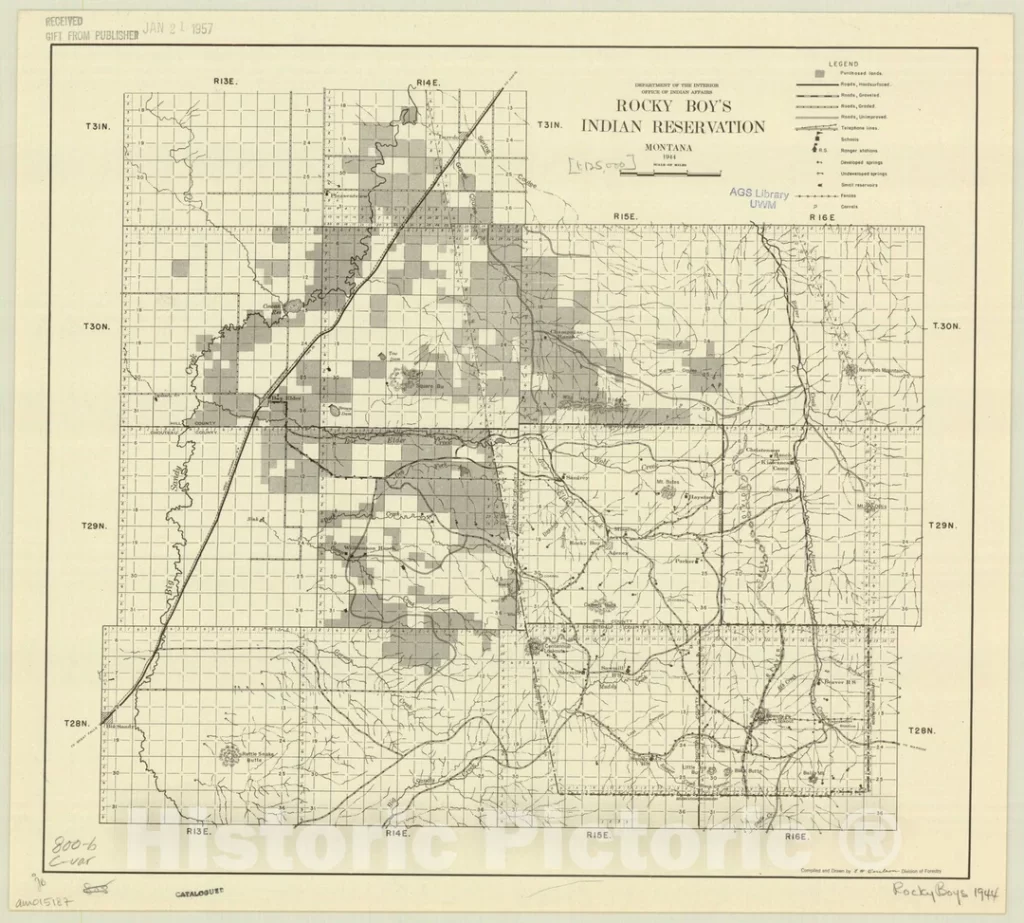
This reservation is home to the Chippewa Cree Tribe and is located in rural north-central Montana. The Rocky Boy’s Reservation was the last of the seven federally recognized reservations to be created in the State of Montana. The Reservation’s unique name can be attributed to their historic Chippewa leader, whose actual name carried the meaning of “Stone Child,” but was mistranslated and consequently the name “Rocky Boy” persists.
The Chippewa, still known as Ojibwa in their ancestral region stretching originally from the eastern seaboard to Montana, maintain a long-standing belief in prophecies. In the late 18th century, a prophecy urged the Ojibwas’ westward migration. Rocky Boy and his band continued westward from Pennsylvania into what is now Montana. The Ojibwa arrived in Montana between 1885 and 1892. Their nomadic life led to the establishment of campsites at Garrison, Missoula, Butte, Wolf Point, Havre, Deer Lodge, Anaconda, Helena, the Flathead, Crow, and the Blackfeet Indian Reservations. They endured homelessness, unspeakable hardship, and racial discrimination from Indians and non-Indians alike. Ojibwa elders conducted pipe ceremonies and prayed for a place where they could practice their way of life and preserve their history.
The Cree Indians originally viewed the Montana Territory as an integral part of their aboriginal homelands and hunted the vast countryside along the Montana and North Dakota borders for centuries. In 1885, Little Bear’s band of Cree fled to Montana to escape Canadian justice after their role in the Frog Lake Massacre. Although they were deported back to Canada in the summer of 1896, they returned to Montana and Little Bear led his band of Cree to join and follow Rocky Boy and his band of Chippewa.
In 1902, Rocky Boy dictated a letter to President Theodore Roosevelt asking him to establish a reservation for his band, but his request was denied. A bill proposed in 1904 to provide a home for Rocky Boy’s Ojibwa was also unsuccessful. Five years later, Rocky Boy’s band was loaded into boxcars and transported to the Blackfeet Indian Reservation. Due to the unsuitable area they were assigned to and the disagreeable living conditions under a government Indian agent, the Chippewa and Cree successfully escaped the guards surrounding their camp and returned to their nomadic lifestyle in pursuit of a new home.

In 1916 President Woodrow Wilson signed a bill into law to set aside land for Rocky Boy’s band and other homeless Indians. Several civic leaders, including Frank Linderman, Charles M. Russell, Paris Gibson, and William Boles helped Rocky Boy to secure land for his people. After more than one hundred years of searching, the Chippewa were able to settle in the Bear Paw mountains with their allies, the Cree, and form a stable community in which to raise their children and pass down the cultural history and beliefs that are an important part of daily life. Today, the Rocky Boy Reservation is home to new generations of Chippewas and Crees, and it is important to preserve the now historic places and structures that are part of the early history of the reservation.
The Reservation lies in the rolling foothills and plains of the Bear Paw Mountains and consists of approximately 128,000 acres, all of which are held in Trust by the Federal government. The nearest urban center is located in Great Falls, Montana which is approximately 100 miles south of the reservation. The Reservation has nearly 6,500 enrolled members of which about 3,900 reside within the exterior boundaries. The Chippewa Cree Business Committee has designated the Chippewa Cree Cultural Resource Preservation Department (CCCRPD) by tribal resolution with the responsibility of preserving and protecting the cultural, spiritual, medicinal, and historical properties deemed significant and unique to the Chippewa Cree people.
In 1935, John Gable, the son of Rocky Boy Lutheran mission pastor William H. Gable created a 35-minute silent film at the mission site on the Reservation.
